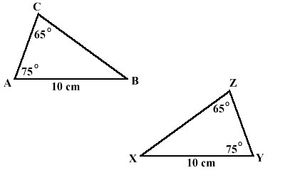Now, let’s explore the magic of corresponding angles. When a transversal line intersects two parallel lines, it creates something special: corresponding angles. These angles are located on the same side of the transversal and in the same position for each line it crosses.
In simpler terms, corresponding angles are congruent, meaning they have the same measurement.
To spot corresponding angles, look for the distinctive “F” formation (either forward or backward), highlighted in red, as shown in the picture at the beginning of the article. In this example, angles labeled “a” and “b” are corresponding angles.
In the main picture above, angles “a” and “b” have the same angle. You can always find the corresponding angles by looking for the F formation (either forward or backward), highlighted in red. Here is another example in the picture below.
In this diagram, line t is the transversal line. Lines a and b are the parallel lines. The angles labeled 1 and 5 are corresponding angles, as are 4 and 8, 2 and 6 and 3 and 7. That means their angles are the same.
Jleedev/Wikimedia Commons/CC BY-SA 3.0
John Pauly is a middle school math teacher who uses a variety of ways to explain corresponding angles to his students. He says that many of his students struggle to identify these angles in a diagram.
For instance, he says to take two similar triangles, triangles that are the same shape but not necessarily the same size. These different shapes may be transformed. They may have been resized, rotated or reflected.
Here, we see corresponding angles in triangles. The triangles are different, but their corresponding angles are the same.
Isipeoria~enwikibooks/Wikimedia Commons/CC BY-SA 3.0
In certain situations, you can assume certain things about corresponding angles.
For instance, take two figures that are similar, meaning they are the same shape but not necessarily the same size. If two figures are similar, their corresponding angles are congruent (the same). That’s great, says Pauly, because this allows the figures to keep their same shape.
He says to think of a picture you want to fit into a document:
“You know that if you resize the picture you have to pull from a certain corner. If you don’t, the corresponding angles won’t be congruent; in other words, it will look wonky and out of proportion. This also works for the converse. If you are trying to make a scale model, you know that all of the corresponding angles have to be the same (congruent) in order to get that exact copy you are looking for.”
Applying Corresponding Angles
In practical situations, corresponding angles become handy. For example, when working on projects like building railroads, high-rises, or other structures, ensuring that you have parallel lines is crucial, and being able to confirm the parallel structure with two corresponding angles is one way to check your work.
You can use the corresponding angles trick by drawing a straight line that intercepts both lines and measuring the corresponding angles. If they are congruent, you’ve got it right.
>>> Read full article>>>
Copyright for syndicated content belongs to the linked Source : How To Stuff – https://science.howstuffworks.com/math-concepts/corresponding-angles.htm
















![[News] Japan Develops 10nm Nanoimprint Technology, with Potential to Tackle EUV Bottleneck – TrendForce](https://earth-news.info/wp-content/uploads/2025/12/329851-news-japan-develops-10nm-nanoimprint-technology-with-potential-to-tackle-euv-bottleneck-trendforce-360x180.jpg)
















